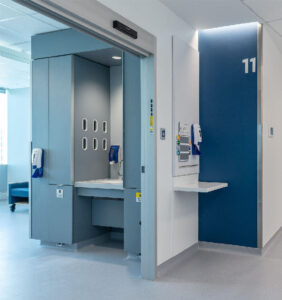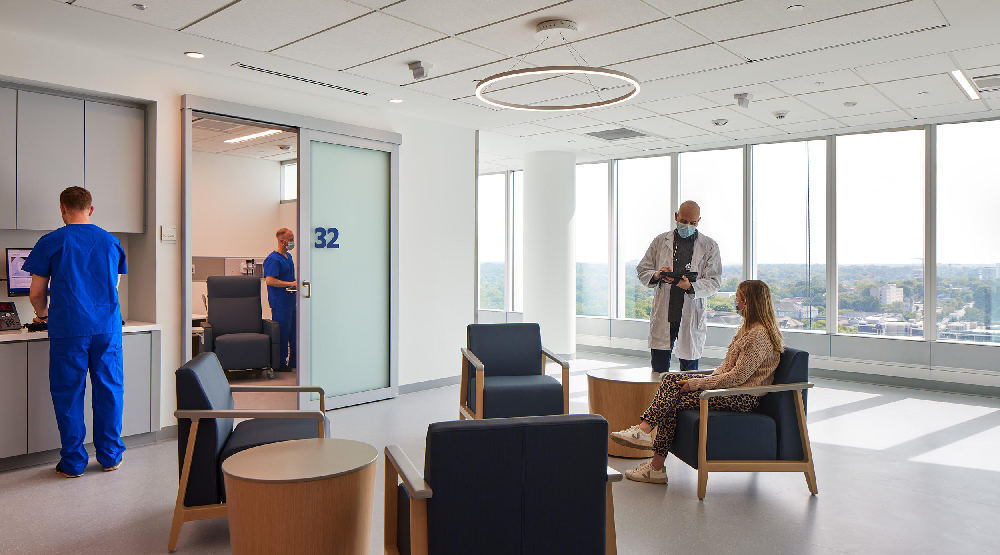Battling HAIs: Where innovation meets prevention
Healthcare organizations dedicate substantial time and resources to craft operational strategies that thwart the spread of infections. From a planning perspective, mandatory codes and guidelines prescribe certain requirements and elements to aid infection control. But that’s only part of the story. There’s a realm beyond regulations where innovation meets prevention. The following explores a few of those strategies and the role they play in preventing healthcare-acquired infections.
The big picture: at the building level
Decentralization & privatization of spaces — When organizing a new building, creating centralized spaces in healthcare design has long been considered a good thing. Consolidating services and staff creates obvious efficiencies. However, when it comes to airborne infectious diseases, it’s advantageous to look beyond the traditional playbook and consider the benefits of a decentralized approach.
Take infusion, for instance. Where the common approach is to create centralized and open infusion centers — where only curtains separate chairs — even then the curtains are usually only drawn for brief privacy during sensitive moments. This approach puts a large immunocompromised patient population in prolonged proximity and potential exposure to a larger number of individuals, such as all the caregivers accompanying the patients in the center.
Consider a different scene, a decentralized approach to infusion centers, waiting spaces and other such areas that reduces the number of patients in a given area, thus reducing exposure. Where space and budget allow, it’s possible to take this a step further and privatize spaces into individual rooms. Other than travel to and from the private room, the patient’s interaction is limited to their immediate care team for the majority of their visit.
Now imagine a concept that takes the art of minimizing exposure to the next level. A universal room approach supports multiple patient activities in the same room. For instance, sticking with the infusion example, when blood draw, examination and infusion can all occur in the same room, the patient is not bouncing around the building from the lab to the clinic to the infusion center. This greatly reduces the patient’s movements and interfaces with risk points throughout the healthcare environment.
The same idea applies to limiting staff movements and exposure points. One such strategy is a nurse server at the inpatient room. This allows a patient room to be restocked from the corridor, reducing support staff movement into the patient room.
Separation of clean & dirty workflows — While regulations specify clean and dirty workflows in specific areas, such as sterile processing, these requirements generally do not extend to the overall building organization. However, these flows should be considered at a macro level, as well.
For example, building loading docks typically handle at least four main flows of material: clean supplies; dirty and biohazardous waste; maintenance personnel and equipment and where a kitchen is present, food supplies. Good practice considers separation of these flows, both in terms of corridors into/out of the building with specific flow directions, and in terms of loading dock space.
Where sterile processing is centralized in a building, thought should be given to the flow of sterile supplies and instrumentation throughout the building. For example, when the perioperative platform is on another floor, having separate clean and dirty elevators reduces the potential for cross-contamination.
In general, the order of events and flow of supplies and waste throughout the entire healthcare environment needs to be reviewed, not just within a room, suite or department. Look for opportunities to create one-directional paths, limiting interaction between clean and dirty. While obvious, this sometimes gets lost in the balance of all the other technical and functional requirements of a project.
Sometimes it’s all in the details
At a room level, there are several strategies to help with cleaning and limit opportunities for cross-contamination.
In operating rooms in particular, replacing 90-degree corners with short 45-degree corners facilitates cleaning, making it harder for bacteria to collect in crevices. Consider hand-wave sensors at automatic doors in lieu of push buttons. And take every opportunity to create continuous, flush, wipeable surfaces in lieu of surface-mounted items that are difficult to clean around.
The use of flash cove base, where possible, eliminates another hard to clean 90 degree transition. Implementing these, beyond where they are considered a requirement, and even sealing the top of the base to the wall goes a step further. Similarly, consider soffit panels to the ceiling above fixed millwork or casework to prevent “dust shelves” throughout the design.
It’s labor-intensive to replace privacy curtains frequently and so they end up being replaced at long intervals or only after a splatter event. As a result, many organizations are transitioning to disposable curtains or are committing to eliminating privacy curtains altogether throughout their facilities. Alternate strategies include privacy door swings (where a door opens in the direction that shields the view of the patient in the room from the corridor) and integral blinds in view windows.

Hand-washing receives a lot of attention on the operational side of healthcare delivery, but there are also design and facility considerations that can support consistent hand-washing practice. Placing sinks immediately adjacent to the entry of a room, vs. across the room, puts hand-washing as the first thing a provider does when entering a room. Offsetting the drain location in the sink basin from the faucet reduces splash from the drain that might contain bacteria. Placing accessories outside of the splash zone also reduces cross-contamination opportunities. Use of sensors or foot pedals eliminates a touchpoint. And providing an integral sink with the counter where possible eliminates yet more crevices.
While sometimes controversial, from a facilities perspective there also are multiple hand-hygiene monitoring systems available for the healthcare environment. These systems typically work via a badge worn by staff interfacing with a wireless sensor at a hand sanitizer or hand-washing station. The system confirms the badge wearer utilizes the station prior to entering the patient zone.
Engaging the right people at the right time
Like all efforts to improve safety, success lies not in a single approach or with a single person or department. Instead, prevention of HAIs depends on everyone and everything involved in the healthcare environment, from the clinical staff, to environmental services to the design and construction teams.
And it’s important to engage the right people at the right time in the process. Often, we see the infection prevention staff reviewing completed designs for “compliance.” Better results occur when they are at the design table from the beginning, being a part of the balancing act between operations, patient experience and cost, for example.
The same is true for environmental services personnel. Their input is frequently limited to the design and location of the EVS rooms. However, they are the most knowledgeable about the challenges they face in cleaning and sanitizing spaces, from what materials hold up best to the cleaning solutions and methods they use, to which design details make it easier for them to do their job. Their experience helps drive design solutions.
Particularly when working in occupied buildings, pre-construction risk assessments and infection control risk assessments become paramount. These assessments and the plan implementation require close collaboration, communication and follow-through between the architect, the contractor, the end users in the affected spaces and the infection prevention department to be successful. The operational requirements and needs of the surrounding spaces must be clearly delineated and understood by all parties.
These are just a few strategies toward helping to prevent the spread of infection. As rigorous research yields even better understanding, new approaches will continue to be developed. Ultimately, it’s the entire spectrum of everyone involved in planning, designing, constructing and operating healthcare buildings working together that achieves success in preventing HAIs.





